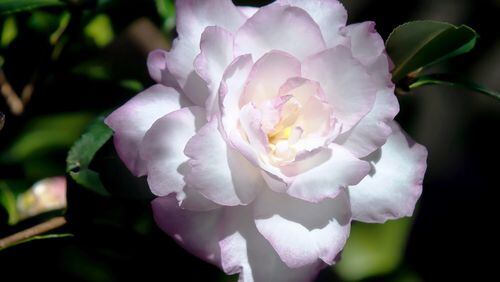The beautiful Leslie Ann is a Camellia sasanqua that has had admirers bringing out their cameras for many years. It debuted in 1960, 58 years ago, thanks to nurseryman Ray Davis of Alabama. The next year in 1961 it won the coveted Ralph Peer Camellia sasanqua award. According to one website in Alabama it is one of two Camellias sasanqua to win the award twice.
As a horticulturist, it has always amazed me when an old timer wins a coveted award. By old-timer, I am not talking the gardener though that might be appropriate, but, instead, I am referring to the plant. In the 1980s, I remember the old variety, Desirable; it was quite stunning at a major show.
That probably pales in comparison though to Double Delight winning a coveted rose award when I was Director of the American Rose Society in the early 1990s. But when you think about a shrub hanging around for more than half a century all the while garnering prestigious awards, that truly is something extra special.
Leslie Ann has done just that. In 2015 it was selected as a Louisiana Super Plant. In reality, though it has won much more than that, because in virtually every state where camellias can be grown Leslie Ann is still high on the recommended list.
Leslie Ann Camellia sasanqua is, of course, an evergreen shrub offering you the opportunity to use it as part of the bones or structure in your landscape. You would love it even if it didn’t bloom. Striking, glossy deep green foliage on a shrub that reaches 8- to 10-feet tall and 4- to 6-feet wide makes it most worthy.
It does bloom, however, opening to show a fully formal double, with white, and luscious raspberry pink margins. The flowers are seemingly produced for months from October through December. One of the attributes that you will notice however is that no matter the stage of bloom it seems to be drop-dead gorgeous. You will treasure it at all stages.
Leslie Ann is cold hardy to zone 7 and makes as beautiful of a container plant as it does a specimen in the landscape. Grow Leslie Ann and I’m sure it will become your Super Plant too!
Leslie Ann is recommended for full to part sun. Camellia sasanqua can tolerate a lot more sun than you would expect. Fertile, organic rich, acidic soil is best. Leslie Ann, Yuletide, and the October Magic series from the Southern Living Plant Collection, were the first shrubs planted in my new landscape and I can tell you they can thrive in heavier soil conditions but good drainage is paramount.
When planting, make your holes 3 times the width of the pot and plant with the top of the rootball 1- to 2-inches above the soil surface. Don’t count on rain, water, and apply a good layer of mulch. Spring will be a great time to find them for sale and a terrific time to plant.
While I treasure them in the landscape, I am admiring them also growing in large mixed containers combined with Gold Mound chamaecyparis, purple leafed heuchera, lamiums and pansies for an amazing cool season display. If you live in an area that can grow camellias then, by all means, include the award-winning Leslie Ann sasanqua among your choices.
———
Norman Winter, horticulturist, garden speaker and author of, “Tough-as-Nails Flowers for the South” and “Captivating Combinations: Color and Style in the Garden.” Follow him on Facebook @NormanWinterTheGardenGuy.
About the Author






